This post originally appeared on Murder Is Everywhere.
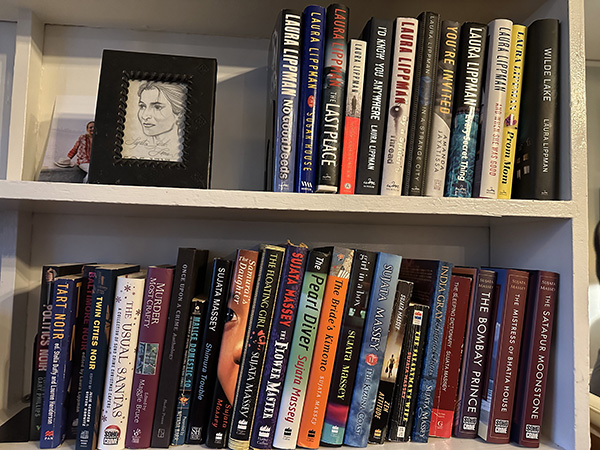
The Amazon-owned Washington Post recently reported on a poll by The Economist/YouGov on people’s reading habits.
Forty-six percent of people living in the United States read no books last year. Just five percent read one book. This book reading rate was about the same as when I began my writing career in the 1990s. Apparently, the top one percent in the survey were people who read 50 books or more a year. I know los of these people. Truthfully, I probably read thirty books a year, which ranks as the 88th percentile.
The public indifference to books makes the existence of the publishing industry—and advances paid for some flashy books—utterly bizarre. People don’t naturally turn to books for fun, no matter how hard we writers wish to entertain, comfort, provoke, or inform.
But I love writing. And one side effect of being a writer is it the accumulation of printed matter. Whenever I have a book published, I’m gifted 25 free copies from the US publisher—and at least 5 copies on average from the foreign publishers who choose to translate one of my books. This means several hundred of the books in the house are my own; volumes I’m not likely to be rereading. So why do I keep them? Why, for all the right reasons. I give them away to people who help me with my work, relatives, and the special person who’s able to read a Rei Shimura novel in German or a Perveen Mistry book in Korean. And looking at them on the shelf is a reminder that no matter how much I’m struggling, I can get a book written.
But my own works are probably only five percent of what’s stored in the house. Even though I regularly purge, I have overstuffed bookcases, a common situation for someone who loves to read and write. I coddle the books I’ve loved by housing them carefully with the intent of rereading. Yet so many new books come into my life each year that I rarely reopening a loved book.
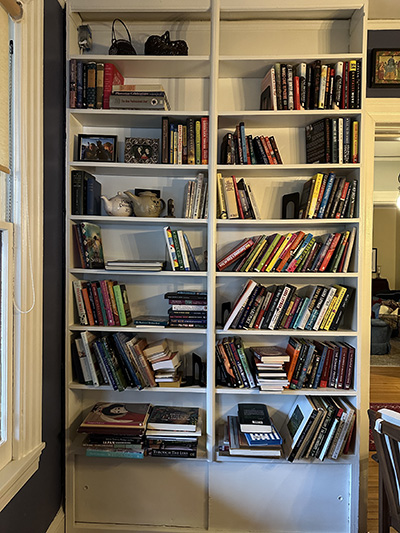
I have written about decluttering books before—my journeys hauling books to Little Book Libraries around town, to the drop-off point for Books for Africa, to the loading dock for the Maryland Book Bank, and also to used bookstores, before so many of them went out of business.
This past weekend I looked at my shelves and saw how they were overflowing. So I took a deep breath and brought down some boxes to load up and take to the Maryland Book Bank, which is just a couple of miles away. This felt like my harshest purge ever. I took away books that I consider excellent, often saving just my very favorite by a particular author. Some series, like those by friends Marcia Talley, Laura Lippman, and Lauren Henderson, remained intact. If you are a book person, you know how hard it is to break up a collection; even if the books aren’t being read anymore, they feel like family members who want to stay.
This time around, I am looking at things from a different perspective: that of the built-in bookcases that flank my dining room entrance. The narrow bookcases, clearly added by some do-it-yourselfer many decades ago, make up a total of 32 shelves rising almost eight feet high. The bookcases seemed to be crying out to be treated with respect, not like a dumping ground.
Lately it’s seemed that my YouTube and Instagram feeds are packed with examples of beautiful bookcases, often painted in a bold color and wallpapered. They are serene spaces that show art and flowers and short runs of books, usually color-coordinated, or all looking vintage. Recently I stayed in a hotel where the bookcase in the suite held very old books—some dating from the late 1700s. The glamour of the curated bookcase has gone off the charts.
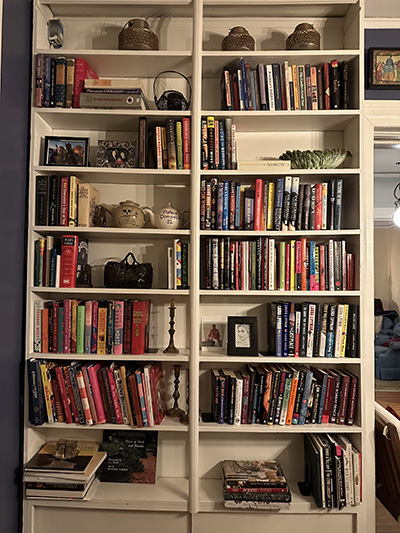
The people who style such bookcases probably aren’t ones who buy upwards of fifty books a year (yes, I buy more than I can possibly read). If it’s a year that I’m on a judging committee, between 150 and 500 books will be shipped to my house. Where do all my books live? Seven designated storage areas in the house (three studies, the living and dining rooms, the butler’s pantry, and a guest room). Oops, space eight is the floor next to my bed!
Recently, an interior designer walked through my home. I had invited her because of a vague feeling I want change in the house. The designer pointed out that there are too many visual elements pulling at the eye. She did not single out books—in fact, she kindly said, “books are the best thing” but she proposed a new bookcase for me. But before I jump to having this installed, I decided to see what I might do with the purge and making my own stab at styling a bookcase that included negative space. As I did the tedious work, hauling books here and there, alphabetizing others and making groupings for history, mystery, cooking and gardening, I took breaks to ponder how-to articles and peruse “beautiful bookcases” on the Internet. This made me decide to group my vintage cloth- and paper-bound volumes together. If I had a square book that didn’t fit the shelf, I faced it out. Bookcase styling is about judging a book by its cover. It’s a way of experiencing my own aged book collection as if I were shopping somewhere browsing books I’d like to own.
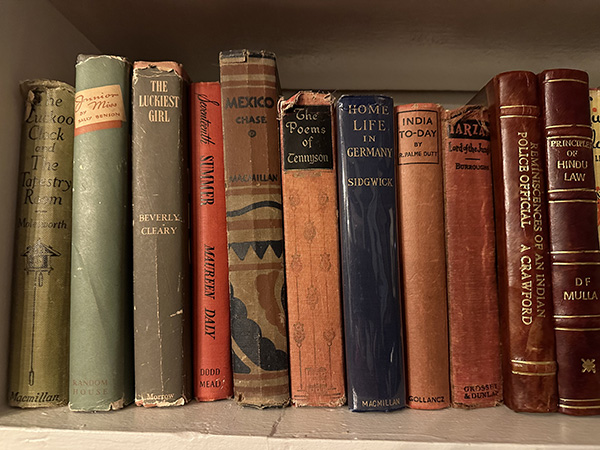
Some midlifers feel unfulfilled until they buy a luxury car. And then there are those who throw over their old partner for someone younger and hotter. Reinventing my dust-collecting bookshelves feels like a daintier rebellion. It’s my way of playing against tradition. I’m even thinking that in the next few months, the scarred white wooden shelves could be painted dark blue. Fabric on the back wall, or a decorative paper. And what about a few strategic spotlights?
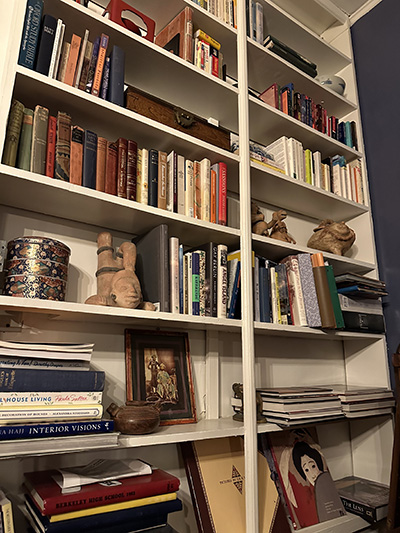

Hi Sujata,
I am very intrigued by the book titled ‘Home Life in Germany’ on your shelf. I live in Germany and would love to read it, but I’m guessing it’s not available in a recent e-book. Also, I grew up in Portland and was happy to see Beverley Cleary on your shelf- we consider her one of our own.
I am definitely a 50+ books a year reader – so a discerning, experienced book lover-! – and discovering you as a writer last year has brought me so much joy! I LOVE your Perveen Mistry books! They are amazing! I am right in the middle of ‘The Mistress of Bhatia House’ and want to slow down and savor every word and simultaneously gulp it up in one sitting!
I LOVE THE SERIES, I love being immersed in 1920s India (facing reproductive rights & women’s autonomy issues as we do today). There’s no way I could convey how much I appreciate your writing, I just do.
I have also read one Rei Shimura book and am so eager to get my hands on the others. I lived in Japan as an English teacher for three years in the late ’80s and it is so fun to revisit it in your pages. And you do such a wonderful job of ‘explaining’ the culture without being annoying about it. I can’t explain how rare that is. Usually I get impatient at non-native takes on Japan, but I fully relaxed into your description of it.
You are an amazingly talented writer and I can’t believe it’s taken me so long to discover you – it’s probably because I live in rural Germany – thank you, thank you, thank you for your books which have already given me so many happy hours.
Cousin Sujata – A woman I met at a seminar in October asked if I was related to you and if I’d read your Rei Shimura mysteries. I had shared that I was “made in Japan” in Nagoya in October 1950 and had always felt drawn to oriental art and culture.
After reading your wonderful Rei series I must thank you for bringing me back to my Japanese roots thru your stories!
My family lived in Taiwan when I was in my early teens where my brothers and I attended a missionary school. We were the only Air Force family that was never stationed in Germany as my father was sent to Japan, Korea, Taiwan and Vietnam. My mother was quite artistic and collected china and lots of decorative items.
I read over a 100 books per year and have stacks of them in our house in Austin TX. My wife tolerates my addiction.
Thank you again for bringing me home!